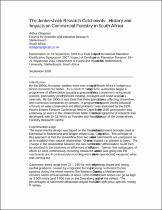 ResearchSpace
ResearchSpace
Jonkershoek research catchments: history and impacts on commercial forestry in South Africa.
JavaScript is disabled for your browser. Some features of this site may not work without it.
- ResearchSpace
- →
- Research Publications/Outputs
- →
- Conference Publications
- →
- View Item
| dc.contributor.author |
Chapman, A

|
|
| dc.date.accessioned | 2010-08-19T12:41:35Z | |
| dc.date.available | 2010-08-19T12:41:35Z | |
| dc.date.issued | 2007-09 | |
| dc.identifier.citation | Chapman, A. 2007. Jonkershoek research catchments: history and impacts on commercial forestry in South Africa. Field Day of the International Plantation Certification Symposium 2007: Impact of Certification on Plantation Forestry. Stellenbosch, South Africa. 18-21 September 2007, pp 2 | en |
| dc.identifier.uri | http://hdl.handle.net/10204/4174 | |
| dc.description | 2007: International Plantation Certification Symposium, Stellenbosch, South Africa | en |
| dc.description.abstract | By the 1850s, European settlers were over-exploiting of South Africa’s indigenous forest resources for timber. As a result of rising concerns, authorities began a programme of afforestation (usually a grassland or fynbos conversion) using exotic species, particularly pines (P pinaster initially), eucalypts and some acacias (A. mearnsii). By the 1900s it was clear that these plantations were affecting streamflow, with numerous complaints by farmers. A programme of research into “the influences of forests on water conservation and allied problems” was endorsed by the 1935 Fourth Empire Forestry Conference held in Cape Town. By 1936 construction was underway on weirs in the Jonkershoek State Forest and a programme of research was developed, with Dr CL Wicht as Founder and Research Director of the Jonkershoek Forestry Research Centre. | en |
| dc.language.iso | en | en |
| dc.subject | Jonkershoek research catchments | en |
| dc.subject | Streamflow | en |
| dc.subject | Water conservation | en |
| dc.subject | Plantations | en |
| dc.subject | Weirs | en |
| dc.subject | Commercial forestry | en |
| dc.title | Jonkershoek research catchments: history and impacts on commercial forestry in South Africa. | en |
| dc.type | Conference Presentation | en |
| dc.identifier.apacitation | Chapman, A. (2007). Jonkershoek research catchments: history and impacts on commercial forestry in South Africa. http://hdl.handle.net/10204/4174 | en_ZA |
| dc.identifier.chicagocitation | Chapman, A. "Jonkershoek research catchments: history and impacts on commercial forestry in South Africa." (2007): http://hdl.handle.net/10204/4174 | en_ZA |
| dc.identifier.vancouvercitation | Chapman A, Jonkershoek research catchments: history and impacts on commercial forestry in South Africa; 2007. http://hdl.handle.net/10204/4174 . | en_ZA |
| dc.identifier.ris | TY - Conference Presentation AU - Chapman, A AB - By the 1850s, European settlers were over-exploiting of South Africa’s indigenous forest resources for timber. As a result of rising concerns, authorities began a programme of afforestation (usually a grassland or fynbos conversion) using exotic species, particularly pines (P pinaster initially), eucalypts and some acacias (A. mearnsii). By the 1900s it was clear that these plantations were affecting streamflow, with numerous complaints by farmers. A programme of research into “the influences of forests on water conservation and allied problems” was endorsed by the 1935 Fourth Empire Forestry Conference held in Cape Town. By 1936 construction was underway on weirs in the Jonkershoek State Forest and a programme of research was developed, with Dr CL Wicht as Founder and Research Director of the Jonkershoek Forestry Research Centre. DA - 2007-09 DB - ResearchSpace DP - CSIR KW - Jonkershoek research catchments KW - Streamflow KW - Water conservation KW - Plantations KW - Weirs KW - Commercial forestry LK - https://researchspace.csir.co.za PY - 2007 T1 - Jonkershoek research catchments: history and impacts on commercial forestry in South Africa TI - Jonkershoek research catchments: history and impacts on commercial forestry in South Africa UR - http://hdl.handle.net/10204/4174 ER - | en_ZA |





